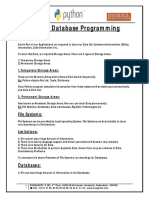0 ratings0% found this document useful (0 votes)
35 viewsPython Unit - 5
This document provides an introduction to basic database operations and SQL using Python, covering topics such as connecting to databases, creating tables, and performing CRUD operations (Insert, Select, Update, Delete). It also discusses various database adapters for Python, including PyMySQL and MySQLdb, and explains the use of regular expressions in Python for pattern matching. Additionally, it includes examples of SQL commands and regular expressions, demonstrating their applications in database programming.
Uploaded by
SATHISHKUMARCopyright
© © All Rights Reserved
We take content rights seriously. If you suspect this is your content, claim it here.
Available Formats
Download as PDF, TXT or read online on Scribd
0 ratings0% found this document useful (0 votes)
35 viewsPython Unit - 5
This document provides an introduction to basic database operations and SQL using Python, covering topics such as connecting to databases, creating tables, and performing CRUD operations (Insert, Select, Update, Delete). It also discusses various database adapters for Python, including PyMySQL and MySQLdb, and explains the use of regular expressions in Python for pattern matching. Additionally, it includes examples of SQL commands and regular expressions, demonstrating their applications in database programming.
Uploaded by
SATHISHKUMARCopyright
© © All Rights Reserved
We take content rights seriously. If you suspect this is your content, claim it here.
Available Formats
Download as PDF, TXT or read online on Scribd
You are on page 1/ 8
UNIT – 5 BASIC DATABASE OPERATIONS AND SQL
Database Programming – Introduction - Basic Database Operations and Connect To Database
SQL - Example of using Database Adapters, Mysql - Regular To connect the python into the SQL.
Expression – Special Symbols and Characters – REs and Python. import sqlite3
conn = sqlite3.connect('test.db')
DATABASE PROGRAMMING
print "Opened database successfully";
INTRODUCTION
Database is the basis for SQL, MS SQL Server, IBM DB2,
Create a Table
Oracle, MySQL, and Microsoft Access.
To create the new table.
Python supports various databases like SQLite, MySQL,
import sqlite3
Oracle, Sybase, PostgreSQL, etc.
conn = sqlite3.connect('test.db')
Python also supports Data Definition Language (DDL), Data
print "Opened database successfully";
Manipulation Language (DML) and Data Query Statements.
conn.execute('''CREATE TABLE COMPANY
Table: Related data that consists of columns and rows.
(ID INT PRIMARY KEY NOT NULL,
Field: Small entities in a table.
NAME TEXT NOT NULL,
Record: A record is a horizontal entity in a table.
AGE INT NOT NULL,
Column: A record is a vertical entity in a table.
ADDRESS CHAR (50),
Example:
SALARY REAL);''')
print "Table created successfully";
conn.close()
V. Naresh Kumar, M.C.A., M.Phil., Page 1
Insert Operation Select Operation
To insert the record into the table. To select the particular field of record.
import sqlite3 import sqlite3
conn = sqlite3.connect('test.db') conn = sqlite3.connect('test.db')
print "Opened database successfully"; print "Opened database successfully";
conn.execute ("INSERT INTO COMPANY (ID, NAME, AGE, cursor = conn.execute("SELECT id, name, address, salary from
ADDRESS, SALARY) \ COMPANY")
VALUES (1, 'Paul', 32, 'California', 20000)"); for row in cursor:
conn.execute("INSERT INTO COMPANY print "ID = ", row[0]
(ID,NAME,AGE,ADDRESS,SALARY) \ print "NAME = ", row[1]
VALUES (2, 'Allen', 25, 'Texas', 15000)"); print "ADDRESS = ", row[2]
conn.commit() print "SALARY = ", row[3], "\n"
print "Records created successfully"; print "Operation done successfully";
conn.close() conn.close ()
V. Naresh Kumar, M.C.A., M.Phil., Page 2
Update Operation Delete Operation
To edit or update the particular record in the table. To delete the particular record in the table.
import sqlite3 import sqlite3
conn = sqlite3.connect('test.db') conn = sqlite3.connect('test.db')
print "Opened database successfully"; print "Opened database successfully";
conn.execute("UPDATE COMPANY set SALARY = 25000.00 conn.execute("DELETE from COMPANY where ID = 2;")
where ID = 1") conn.commit()
conn.commit print "Total number of rows deleted :", conn.total_changes
print "Total number of rows updated :", conn.total_changes cursor = conn.execute("SELECT id, name, address, salary from
cursor = conn.execute("SELECT id, name, address, salary from COMPANY")
COMPANY") for row in cursor:
for row in cursor: print "ID = ", row[0]
print "ID = ", row[0] print "NAME = ", row[1]
print "NAME = ", row[1] print "ADDRESS = ", row[2]
print "ADDRESS = ", row[2] print "SALARY = ", row[3], "\n"
print "SALARY = ", row[3], "\n" print "Operation done successfully";
print "Operation done successfully"; conn.close()
conn.close()
V. Naresh Kumar, M.C.A., M.Phil., Page 3
EXAMPLE OF USING DATABASE ADAPTERS 3. QTSQL
Introduction: QTSQL is a database connector.
Python offers database adapters through its modules It is used to integrate databases with PYQT5 applications.
that allow access to major databases such as, Example:
1. MySQL self.QSqlDatabase.addDatabase("QMYSQL")
2. PostgreSQL self.db.setHostName("host_name")
3. SQL Server self.db.setDatabaseName("database_name")
4. SQLite. 4. Psycopg2
Database Adapters It is the most popular PostgreSQL database adapter for the
1. PyMySQL Python programming language.
It is an open source. It was designed for multi-threaded applications.
It is a multiuser, multithreaded. Example:
Mainly used in web development. import psycopg2
Example: try:
import pymysql conn = psycopg2.connect("dbname='template1' user='dbuser'
con = pymysql.connect('localhost', 'username', host='localhost' password='dbpass'")
'password', 'db_name’') except:
print(f'Database version: {version[0]}') print "I am unable to connect to the database"
con.close() 5. SuperSQLite
2. MySQLdb It is a driver for Python.
MySQLdb is a thread-compatible interface to the MySQL It replaces the built-in newer version of SQLite.
database server. Example:
It provides the Python database API. from supersqlite import sqlite3
Example: conn = sqlite3.connect('databasefile.db')
db=_mysql.connect (host="localhost",user="username",
passwd="password",db="db_name")
V. Naresh Kumar, M.C.A., M.Phil., Page 4
MYSQL Or you can try to access the database when making the connection:
Introduction Try connecting to the database "mydatabase":
Python can be used in database applications. Example:
One of the most popular databases is MySQL. import mysql.connector
mydb = mysql.connector.connect(host="localhost",
Creating a Database
user="yourusername", password="yourpassword",
To create a database in MySQL, use the "CREATE
database="mydatabase")
DATABASE" statement:
Example:
import mysql.connector
mydb = mysql.connector.connect(host="localhost",
user="yourusername", password="yourpassword")
mycursor = mydb.cursor()
mycursor.execute("CREATE DATABASE mydatabase")
Check if Database Exists
Check if a database exist by listing all databases in your
system by using the "SHOW DATABASES" statement:
Example:
import mysql.connector
mydb = mysql.connector.connect(host="localhost",
user="yourusername", password="yourpassword")
mycursor = mydb.cursor()
mycursor.execute("SHOW DATABASES")
for x in mycursor:
print(x)
V. Naresh Kumar, M.C.A., M.Phil., Page 5
REGULAR EXPRESSION SPECIAL SYMBOLS AND CHARACTERS
Introduction Metacharacters
It is a sequence of characters that forms a search pattern. [] - A set of characters
Regular Expression can be used to check if a string contains ^ - Starts with
the specified search pattern. $ - Ends with
Regular Expression Module * - Zero occurrences
Python has a built-in package called re. | - Either or
re can be used to work with Regular Expressions. () - group
Import the re module:
import re Special Sequences - A special sequence is a \ followed by one of the
Example: characters.
//Check if the string starts with "The" and ends with "Spain": \A - Return the characters are at beginning of the string.
import re \b - Return the beginning & end of the word in the string.
txt = "The rain in Spain" \d - Returns the string contains digits (from 0-9).
x = re.search("^The.*Spain$", txt) \D - Returns the string does not contain digits (from 0-9).
if x: \s - Returns the string contains a white space character.
print("YES! We have a match!") \S - Returns the string does not contain a white space.
else:
print("No match")
SPECIAL SYMBOLS AND CHARACTERS
V. Naresh Kumar, M.C.A., M.Phil., Page 6
Sub()
Sets Replaces the matches.
A set is a set of characters inside a pair of square brackets []. Example:
[arn] - Returns a match where specified characters. import re
[a-n] - Returns a match for any lower case character. txt = "The rain in Spain"
[0-9] - Returns a match for any digit between 0 and 9. x = re.sub("\s", "9", txt)
Findall() print(x)
Returns a list containing all matches.
Example:
import re
txt = "The rain in Spain"
x = re.findall("ai", txt)
print(x)
Split()
Returns a list where the string has been split.
Example:
import re
txt = "The rain in Spain"
x = re.split("\s", txt)
print(x)
V. Naresh Kumar, M.C.A., M.Phil., Page 7
REs AND PYTHON group() - Return the string matched by the RE.
The Backslash Plague start() - Return the starting position of the
\section - Text string to be matched match.
\\section - Escaped backslash for re.compile () end() - Return the ending position of the
\\\\section - Escaped backslashes for a string m;atch
Literal span() - Return a tuple containing the (start,
Performing Matches end) positions of the match
match() - Determine if the RE matches at the Example:
beginning. import re
of the string. txt = "The rain in Spain"
search() - Scan through a string, looking for any x = re.split("\s", txt)
location print(x)
where this RE matches.
findall() - Find all substrings where the RE
matches, and
returns them as a list.
finditer() - Find all substrings where the RE
matches, and returns them as
an iterator.
V. Naresh Kumar, M.C.A., M.Phil., Page 8
You might also like
- Python Class 11 Full Book Sumita Arora Good Quality Print87% (195)Python Class 11 Full Book Sumita Arora Good Quality Print530 pages
- Practical11 Python Programming CkC21BUjW7No ratings yetPractical11 Python Programming CkC21BUjW710 pages
- Python Database Programming Study Material PDF100% (1)Python Database Programming Study Material PDF17 pages
- 27 Python Database Programming Study Material PDF100% (1)27 Python Database Programming Study Material PDF17 pages
- 70 Python Experiment No. 14 Nakhwa Arman AnisNo ratings yet70 Python Experiment No. 14 Nakhwa Arman Anis13 pages
- Python Database Programming: Storage AreasNo ratings yetPython Database Programming: Storage Areas11 pages
- AIR TRAVEL MAMAGEMENT FINAL INVESTIGATORY PROJECTNo ratings yetAIR TRAVEL MAMAGEMENT FINAL INVESTIGATORY PROJECT18 pages
- 441761879-Investigatory-project-Contact-Book convNo ratings yet441761879-Investigatory-project-Contact-Book conv38 pages
- Advanced Python Programming Practical ManualNo ratings yetAdvanced Python Programming Practical Manual29 pages
- SBL Python LAB Manual by NY Expt. No. 6.docxNo ratings yetSBL Python LAB Manual by NY Expt. No. 6.docx5 pages
- Chapter 12: Interface Python With An SQL Database100% (1)Chapter 12: Interface Python With An SQL Database4 pages
- Resource 20200613110203 Assignment 9-Class Xii-Computer Science (Sql-Python-Interface) PDFNo ratings yetResource 20200613110203 Assignment 9-Class Xii-Computer Science (Sql-Python-Interface) PDF5 pages
- 2 Interface Python With Mysql - ProgramsNo ratings yet2 Interface Python With Mysql - Programs2 pages
- Lesson Plan Template: John Hopkins University School of EducationNo ratings yetLesson Plan Template: John Hopkins University School of Education3 pages
- Download A City Cannot Be a Work of Art: Learning Economics and Social Theory From Jane Jacobs Sanford Ikeda ebook All Chapters PDF100% (1)Download A City Cannot Be a Work of Art: Learning Economics and Social Theory From Jane Jacobs Sanford Ikeda ebook All Chapters PDF41 pages
- HPE ProLiant DL360 Gen10 Plus server-a50002559enw (1)No ratings yetHPE ProLiant DL360 Gen10 Plus server-a50002559enw (1)66 pages
- Carnival Dialogue and Musical Narrativit PDFNo ratings yetCarnival Dialogue and Musical Narrativit PDF61 pages
- Department of Education: Remediation/Intervention For Learners in Mapeh 8 S.Y. 2022-2023No ratings yetDepartment of Education: Remediation/Intervention For Learners in Mapeh 8 S.Y. 2022-20235 pages
- Attempt History: Points 100 Questions 30 Time Limit 50 MinutesNo ratings yetAttempt History: Points 100 Questions 30 Time Limit 50 Minutes14 pages
- The Guide, Nettippakarana, Nanamoli, 1977No ratings yetThe Guide, Nettippakarana, Nanamoli, 1977404 pages
- Liceul Teoretic "Mihail Sadoveanu" Manual: Upstream Upper Intermediate B2+ Clasa: 10G 3 Ore/săptămână Profesor: Cristina Ioana NistorNo ratings yetLiceul Teoretic "Mihail Sadoveanu" Manual: Upstream Upper Intermediate B2+ Clasa: 10G 3 Ore/săptămână Profesor: Cristina Ioana Nistor5 pages
- Bai Tap Anh 5 Global Unit 5 MY FUTURE JOBNo ratings yetBai Tap Anh 5 Global Unit 5 MY FUTURE JOB14 pages
- Al Adab Al Mufrad (درفملا بدلأا) - Class #21 Book of CompassionNo ratings yetAl Adab Al Mufrad (درفملا بدلأا) - Class #21 Book of Compassion2 pages

























































































